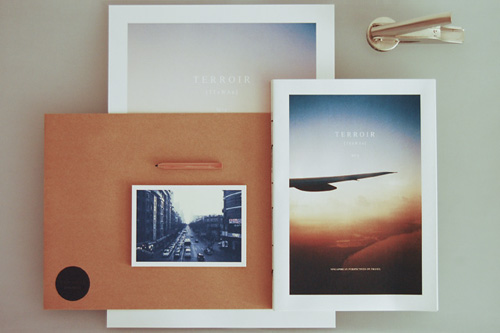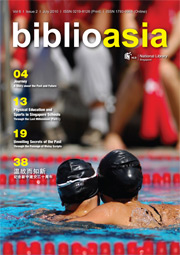After I wrote about how Singaporean creatives were re-shaping our local mediascape, I was told of another that has just launched: Terroir Magazine. This is a bi-annual magazine that features travel photography from Singaporeans, and as it French name suggests (roughly translates to “a sense of place”), the magazine is a collection of Singaporeans perspectives on places they’ve been. I’ve yet to read the magazine, but it’s a topic which could lend to photo essays that make places look exotic, but also provide an “outside-in” perspective of looking at how Singaporeans see the world in relation to this city.
Terrior is self-published in the entire sense. The first issue is produced in the home of founder Benjamin Koh — all 160 pages of each issue are printed using his four inkjet printers before he glues and stitches them together. It’s a laborious process, and Benjamin can produce only up to four magazines a week, after his busy work day at a branding and design firm.
I recently spoke to him over e-mail about this endeavor of his:
How did the idea of Terroir Magazine come about?
I have wanted to do a magazine for about as long as I can remember. And it so happened that the photographs from my first trip overseas in eight years (discounting afternoon skirmishes to Johor Bahru for lunch) to Vietnam at the end of last year turned out in this sort of mood that has been rather elusive in my photographs taken in Singapore. So a magazine related to travel photography was mooted. The content would also be more interesting and engaging.
It’s interesting that the magazine is looking at what various places mean to Singaporeans. Why this direction and how did it come about?
It is rather eye-opening to witness the emancipation of photography, from people who could afford to buy expensive equipment to (almost) every man on the street. The influx of people carrying DLSRs on Orchard Road in recent years is testament that digital photography has actually gotten more people interested in photography than ever before.
And then there is the “lomography” movement of high-contrast, saturated and colourful photographs taken by (mostly) plastic film cameras.
So it got me thinking that a magazine showcasing talented local photographers might work, but definitely not with photographs about Singapore, because we have probably lived here long enough such that we can no longer capture it from a fresh perspective.
Who are the people behind it and how did you all meet?
The first issue of Terroir Magazine is a collaboration between Rachel Han, Michelle Lim, Stephanie Ng and myself.
It is actually pretty amazing but Stephanie came across my work on Behance a few years back. She told Rachel about it when they were doing an internship together in 2010. Rachel and I met up in January this year after she initiated a collaboration and that was when things started to fall in place. I invited Stephanie after that because I really like her photographs.
Michelle is a friend of mine from LASALLE. I have always wanted to work together with her on a project.
What is a designer doing publishing his own magazine?
Purely for the love of it!
The entire magazine is printed on one of your four ink-jet printers and put together by hand. Why not go to a regular printer?
The sheer effort needed to print a single copy of Terroir is now sinking in, but the initial idea was not to let my printers collect dust at home just because I have started working full-time. I am definitely keen to approach a publisher to get on board this project. At least now I will have something to show!
Could you detail the kind of work you have to go about to put together this magazine?
It took quite a few informal meetings, rounds of layout trials, paper and typeface tests before we settled on the final design. We had to trim some content because Coptic-stitch binding requires an even-number total page count.
I had wanted to saddle-stitch the magazine initially, but after printing an entire copy and having bound it that way, I felt that saddle-stitch did not do the magazine justice.
So after the printing of all eight signatures are done, holes have to be poked through them before they can be sewn. It is quite unnerving because poking holes off-centre would mean reprinting an entire signature.
The spine has to be glued before the binding is considered complete. I do not have a bookbinding jig, so I had to improvise — use bookends, hardcover books and magazines to secure the magazine in place for the glue to be applied.
I got the blind-embosser made but had to print wood-free sticker labels black on my inkjet and die-cut them using my circle cutter. After that it is only a matter of blind-embossing the stickers.
What have been some challenges of working this way?
Time! Each copy takes seven hours to print and bind. It takes three more hours for the glue to dry. And then there is the constant worry about misalignments because the paper is very thin, such that the printer’s paper feeder will take it in at slight angles. I have to manually feed every single piece and pray each time I do so.
Wow, $100 for your first issue. Don’t you think your magazine is too expensive for most?
I think the amount of time, effort and dedication that went into the magazine justifies the price. It also takes an incredible amount of ink to print and I have never ever used up so many ink cartridges in my entire life.
Tell us a bit more about what we’ll get to read in the first issue.
The eight places featured in the first issue are: Shanghai, Suzhou, Ho Chi Minh City, Can Tho City, Jeju Island, Nami Island, Sikkim and Bangkok.
———






